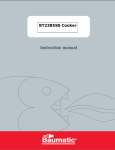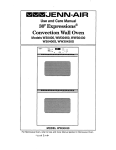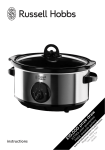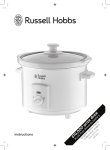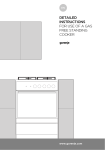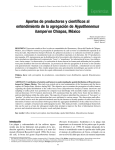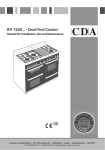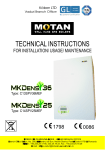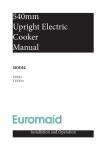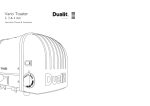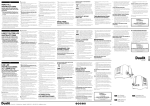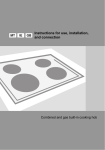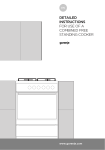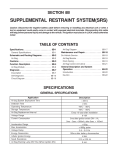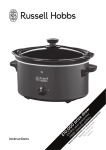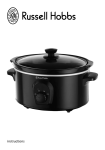Download User Manual - TLC Direct
Transcript
BT2355SS and BT2365SS Freestanding combined cooker User Manual Freestanding combined cooker Dear Customer! Congratulations on your purchase. See for yourself: our products read reliability. These ample instructions have been compiled in order to help you learn how to handle the appliance. They will show you step by step what your appliance is capable of, so please read them carefully before you attempt to use your cooker for the first time. Safety warnings are listed on page 4. The first thing to do is to check if your appliance has arrived undamaged. In case you find any transport damages, please report it immediately to your local dealer, or to the regional warehouse which supplied the appliance. You will find their phone numbers on the invoice or on the delivery note. We hope your cooker will successfully serve its purpose for many years. Contents Safety precautions .......................................... 4 Intended use If you notice any malfunction in the gas installation, or if you smell gas in the room: Electric ignition Prior first use.................................................. 8 Oven Gas cooking zones Gas burner control......................................... 9 Safety cautions in regard to the cooking zones Ignition and operation of burners Cookware Oven .............................................................. 12 Important warnings! Operation Modes of operation Oven guide levels Oven accessories Grease filter Baking pastry Roasting Grilling and browning (barbecue) Preserving of fruit and vegetables Defrosting Cleaning and maintenance...........................22 Gas cooking zones Oven Oven drawer Troubleshooting guide..................................25 Note! Important! Replacement of parts....................................26 Other accessories Oven light bulb Instructions for installation and connection27 Safety precautions for the technician Safety precautions Anti Tilt Bracket Leveling the appliance and extra support Manufacturer's adjustments Gas connections.............................................30 Beginning of operation Installation Requirements and Regulations REGULATIONS Nozzle chart Conversion to another type of gas Setting elements Electrical connections...................................34 Technical specifications................................35 Instructions for use, installation and connection 3 Safety precautions x To avoid any possible hazard, the appliance may be installed by qualified personnel only, authorized by the gas distributing company and by the authorized service. Installation should be carried out in accordance with the legal regulations and technical requirements of the local gas supplier. Important instructions in this regard may be found in the Section "Instructions for installation". x Any repairs by unqualified persons may result in explosion, electric shock or short circuit. In order to avoid possible injuries to your body or to the appliance, do not attempt any repairs by yourself. Such work should be carried out by qualified service personnel. x Before installing and connecting the appliance check whether the specifications of the local gas supplier (type of gas and pressure) correspond to the specifications of the appliance. x Technical specifications of the appliance are indicated on the rating plate. x This appliance is not connected to a chimney or vent opening. The appliance must be installed and connected in accordance with the standing regulations. Special attention should be taken in regard to adequate ventilation. x During the operation of gas burners the room may be filled with extra heat and humidity, so it is necessary to assure adequate ventilation. Occasional opening of the window or door should provide enough exchange of air. During the prolonged use of the appliance, or during a very intense use, more ventilation will be required, and it will probably be necessary to engage the extractor hood. x Hot grease is highly inflammable, so pay extra attention when preparing food with grease or oil. Frying may be carried out only under constant surveillance. 4 x Never clean the oven or the cooktop with hot steam devices or high-pressure jet cleaning device, as they may provoke short circuit. x Before opening the control panel and before any attempted repairs disconnect the appliance from the mains. x Do not keep any flammable material in the drawer under the oven (paper, wiping cloth, plastic bags, cleaning agents or sprays, etc.), as they might cause fire. Use the drawer to keep only the oven utensils (flat baking pan, oil collector, oil filter, etc.). x Mains lead of adjacent appliances may be damaged by cooking zones or if stuck between the oven doors, and produce short circuit, therefore keep them at safe distance from the appliance. x Never use the burners or the oven for heating of the room. Never place empty dishes upon the cooking zones. x Pay special attention to the precise assembly of burner components. x Never put aluminum foil to the bottom of the oven, and do not place any crockery upon the bottom of the oven, since it may impede the air circulation, so the oven enamel may be damaged by the excessive heat. x Warning: do not let small children in the vicinity of the cooker; they are not yet aware of danger of burns. Older children may use the appliance only under your surveillance. x Surface of cooking zones and oven door may become very hot during operation. The inside of the oven, cooking zones and steam exits are also places of potential danger for children, so keep the at adequate distance. x Danger of burns: cooking zones, oven and cooking accessories may become very hot during operation. To avoid burns use kitchen clothes and gloves when handling hot parts or utensils. Instructions for use, installation and connection x Door hinges may be damaged if the open door is charged with heavy objects. Do not sit on the door and never put any heavy loads on the door in the open position. x Rating plate with basic information about the appliance, and the gas type sticker, are located inside the oven and are accessible when the oven door is opened. x The appliance is classified Class 2/1. When positioned in a row it may be located between two adjacent kitchen elements on both sides. On one side it is permitted to install a high kitchen cabinet, higher than the appliance at a distance of not less than 30 cm. x The distance between the appliance and the kitchen hood must be at least 650 mm, or not less than the distance, indicated in the instructions for use of the kitchen hood installation. If you notice any malfunction in the gas installation, or if you smell gas in the room: x immediately shut off the gas inlet or close the gas tank; x extinguish any open flames and tobacco products; x you may not switch on any electric appliances (neither turn on the lights!); x open all windows and provide thorough air circulation! x immediately notify the service center or your authorized gas supplier. The symbol on the product or on its packaging indicates that this product may not be treated as household waste. Instead it shall be handed over to the applicable collection point for the recycling of electrical and electronic equipment. By ensuring this product is disposed of correctly, you will help prevent potential negative consequences for the environment and human health, which could otherwise be caused by inappropriate waste handling of thisproduct. For more detailed information about recycling of this product, please contact your local city office, your household waste disposal service or the shop where you purchased the product. Intended use This gas cooker is intended for traditional use in your household. Never use the appliance for any other purpose! Instructions for use, installation and connection 5 Description of the appliance This is the description of cooker with electric oven and three gas burners and one electric hotplate. Depending on the model, the hob can also be equipped with four gas burners or two gas burners and two electric hotplates. Steam exit Cooktop Control panel Oven door handle Oven glass door Drawer Additional support (certain models only) Adjustable legs (certain models only) - accessible after removing the drawer Steam exit Cooktop Control panel Oven door handle Oven glass door Drawer Additional support (certain models only) Adjustable legs (certain models only) - accessible after removing the drawer 6 Instructions for use, installation and connection 1 1 2 3 4 5 6 7 8 9 3 4 2 5 6 7 8 9 1 Timer 2 G as ignition button (certain models only). 3 Oven ON/OFF button and function mode selection. 4 Oven signal light. On when the oven is heated, and off when the set temperature is reached. 5 Oven temperature selection button Electric ignition (certain models only) Gas burners may be ignited with the electric ignition device, built-in adjacent to each burner. 6 Cooking zone, rear left, normal burner 7 Cooking zone, front left, normal burner 8 Cooking zone, front right, double burner 9 Cooking zone, rear right, auxiliary burner Electric ignition will operate only if the mains lead is plugged into the mains socket. In case of electric failure or damp ignition device, the cooktop burners may be ignited with a simple match or lighter. Instructions for use, installation and connection 7 Prior first use Oven Take all the accessories out of the oven and clean it with warm water and your usual mild detergent. Never use aggressive cleaners as they might cause scratches! During the first heating the oven might produce a somewhat unpleasant smell of a new product. This is normal, just ventilate the place thoroughly! Gas cooking zones There are no special measures to be taken prior first use of gas cooking zones. 8 Instructions for use, installation and connection Gas burner control Cooking burners are controlled by the relevant control knobs. Heating power is indicated on the knobs by the large flame symbol and the small flame symbol. Always turn the knob over the large flame position towards the small flame position and back. The operating position is always between the two flame symbols. Safety cautions in regard to the cooking zones x Never use cooking zones without dishes, or for heating the ambience! x Keep the cooktop clean, since dirt and stains have adversary effect on the functionality of burners. x If you like your food to be crisp, first set the burner to the maximum and continue cooking at minimum power. x Always provide adequate quantity of water when cooking in the pressure cooker. Lack of water may cause damage to the dish and to the cooker. x Cooktop burners are thermally protected. If the burner flame is accidentally extinguished (spilled food, gust of wind) the gas supply is automatically shut. There is no possibility of gas escaping into the room! x If the flame of thermally non-protected cooking burners is accidentally extinguished, the gas escapes into the room! x Be very precise when placing the burner crown cap upon the crown. Always keep the crown nozzles clean and free. Instructions for use, installation and connection crown cap thermal coupling (certain models only) ceratin models only burner crown correct position of burner components 9 Ignition and operation of burners Gas burners may be ignited by means of electric ignition spark plug, fitted adjacent to each burner (certain models only). Single handed ignition (certain models only) To ignite the burner, press the selected burner button and turn it to the maximum power position . Electric spark from the ignition device ignites the gas. If the ignition device is out of order, either due to power failure or humid ignition device, use a match or a lighter to ignite the gas. flame is not stabilized and may be extinguished. x If the flame goes out repeat the procedure. x If the burner flame goes out (for whatever reason), shut the burner off and wait for at least one minute before next attempt. x Note: before igniting the burners (triplering burner, double-ring burner, and Mini Wok) cover them with appropriate cookware. x To shut the burner off turn the button to the right, to the OFF position (CLOSED). Gas faucet is closed Maximum power position Minimum power position Ignition with both hands (certain models only) To ignite the burner, press the selected burner button and turn it to the maximum power position . Now press the ignition device button. Electric spark from the ignition device ignites the gas. If the ignition device is out of order, either due to power failure or humid ignition device, use a match or a lighter to ignite the gas. To facilitate positioning small dishes on the burner grid, place the attached support extension over the auxiliary burner. x Keep the button pressed for approximately 10 seconds after ignition to stabilize the flame. x If you failed to ignite the burner after 15 seconds, shut the burner off and wait for at least one minute before the next attempt. x After that you can set the burning power between high and low position to suit your cooking requirements. x Button positions between in are not recommended. In these positions the 10 Instructions for use, installation and connection Cookware Selection of the adequate dish size ensures optimized cooking time and consumption of gas. Diameter of the dish is of utmost importance. The flame reaching over the edge of the small diameter dish may destroy the dish, while the consumption of gas is increased. Gas needs oxigen for burning. In case of excessively large dish diameter the oxigen supply is insufficient, consequently reducing the burning capacity. The wire grid The wire grid is used for dishes with small diameter. Place the grid over the auxiliary burner crown. Burner type Large (3,0kW) Normal (1,9kW) Auxiliary (1,0kW) Triple-ring (3,5kW) Dish diameter 220-260 mm 180-220 mm 120-180 mm 220-260 mm Instructions for use, installation and connection 11 Oven Important warnings! x Never put aluminum foil to the bottom of the oven, and do not place any crockery upon it. The oven enamel may be damaged by the excessive heat. x Fruit juice, dripping from the baking pan, may produce stains upon the enamel, which are very hard to remove. Operation During all other oven functions the illumination is automatically switched on with the selection of a particular function. Some models have installed two lamps for oven lighting; one at the top of rear wall and the second one at the middle of right-handed side wall . Applying upper and lower heater Heaters from the upper and the lower side uniformly heat the exposed food. Baking and roasting is possible only at single level. Oven is controlled by the function knob and the temperature selection knob. Temperature selection knob Grill Function knob (Please, take into consideration the knob of your appliance) Heat comes directly from the infrared heater, located at the oven ceiling. It is especially suitable for preparing steaks, sausages, T-bones, pork chops, etc. Modes of operation Oven may be used in the following modes. Oven illumination Oven illumination may be switched on independently, without any other function. This may come handy during the cleaning, or when switched off and using the remaining oven heat. 12 Instructions for use, installation and connection Grill with ventilator Defrosting Infrared heater and ventilator operate simultaneously. This mode is appropriate for roasting and grill of larger chunks of meat or poultry at one level. It may also be used to obtain crisp skin on your roast. This is the mode with air, circulating without any of the heaters being turned on. It is used for slow defrosting of food. Lower heater and ventilator Both the lower heater and hot air ventilator are in operation. This mode is most appropriate for baking pizza. It may also be used for baking moist or heavy cake at two levels, fruit cake or cheese souffle. Ventilator with hot air The fan at the rear forces the air around the roast or pastry. It is suitable for roasting and baking at more than one level. Lower heater and ventilator Both the lower heater and ventilator are in operation. The mode is useful for baking low pastry and preparation of preserved fruit and vegetables. Use the first guide level from the bottom, and not too high pans, to allow the air to circulate along the upper side of the food. Applying lower heater/Aqua clean Heat is applied only by the bottom side of the oven. Use this option for browning the bottom side of the food (baking heavy, moist pastry with fruit dressing). The temperature selection button in such cases may be selected as required. Lower heater may also be used for the cleaning of oven. You will find details in the section Cleaning and maintenance. Instructions for use, installation and connection 13 Oven guide levels Grease filter Baking pans and accessories (oven grid, grease receptacle, baking tray, etc.) may be inserted into the oven in 5 guiding levels. Appropriate levels are indicated in the tables that follow. Always count levels from the bottom upwards! In case of wire guides, the grid and the baking pans must always be inserted in the guide slides. Inserted grease filter at the rear panel of the oven protects the fan, the heater and the oven from accidental staining with grease. Always insert the filter when roasting or grilling, and remove the filter when baking pastry. Grease filter might cause unsuccessful baking of some kinds of pastry. Oven accessories (differ according to different models) Oven grid shelf for placing pans and trays, or for food to be prepared using the grill. Flat biscuit tray for baking cake and biscuits. Dripping grease receptacle (deep tray) for moist cake, for roasting or for intercepting dripping oil/grease. 14 Instructions for use, installation and connection Baking pastry Most appropriate position for baking is the application of both upper and lower heater, or the hot air. Note! Grease filter must always be removed! Warnings x When baking pastry, strictly follow the instructions regarding the selection of guide level, temperature and baking time, and do not rely on any previous experience, because information indicated in the baking tables have been determined and tested specially for this particular type of oven. x In case you may not find any particular type of cake in the tables, use the information available for the next most similar type of cake. Baking with upper and lower heater x Use only a single guide level. x This baking position is especially suitable for baking dry pastry, bread and teacakes.Use dark baking pans. Light pans reflect heat and pastry is not adequately browned. x Always place baking pans on the grid rack. Remove the grid only if baking in the flat biscuit tray, supplied with the appliance. x Preheating shortens the baking time. Do not put the cake in the oven until proper temperature is obtained, and until the red signal lamp goes off for the first time. Baking with hot air x This mode of baking is especially suitable for baking at multiple levels, for moist pastry and fruit cakes. x You may use light models. x The temperature is usually lower than baking with upper/lower heater (see Baking Table). x Moist pastry (i.e. fruit cake) may be baked at maximum two levels at the same time, because of excessive humidity. x Different cakes may be baked together if the necessary temperature is approximately the same. x Baking time may be different for different pastry, so you may have to take one pan out before the others. x Cookies, like for example muffins, should be of equal size and thickness. Uneven cookies are baked unevenly. x If you bake more than one cake at the same time, it may produce excessive steaming in the oven and condensation at the oven door. Baking tips Is pastry baked? Pierce the cake with a wooden peg at the thickest part. If the dough does not stick to it, the cake is baked. You may switch off the oven and use the remaining heat. Pastry has fallen Check the recipe. Use less fluids next time. Follow the mixing times, especially when using powered kitchen mixers. Pastry is too light below Use dark baking pan next time, or place the pan one level lower, or switch on the lower heater a while before the completion. Cheese cake is undercooked Next time reduce the baking temperature and extend the baking time. Warnings regarding the baking tables: x The tables indicate the temperature range. Always select lower temperature first. You may always increase the temperature in case pastry needs more baking. x Baking times are indicative only. They may vary in dependence of individual characteristics. x The asterix indicates that the oven requires preheating. Instructions for use, installation and connection 15 Pastry Baking Table Type of pastry Sweet pastry Raisin cake Ring cake Tree cake (tart form) Cheese cake (tart form) Fruit cake Fruit cake with icing Sponge cake* Flake cake Fruit cake, mix dough Cherrycake Jelly roll* Fruit flan Plait bun Cristmass cake Apple pie Puff paste Salted pastry Bacon roll Pizza* Bread Rolls* Cookies Caraway roll Biscuits Danish pastry Flaky pastry Cream puff Deep frozen pastry Apple pie, cheese pie Cheese cake Pizza Chips for oven* Potato fries for oven 16 Guide level (from down upwards) Temp. (°C) Guide level (from down upwards) Temp. (°C) Baking time (in min.) 2 2 2 2 2 2 2 3 3 3 3 3 2 2 2 2 160-170 160-170 160-170 170-180 180-190 170-180 170-180 180-190 170-180 180-200 180-190 160-170 180-200 170-180 180-200 170-180 2 2 2 3 3 3 2 3 3 3 3 3 3 3 3 3 150-160 150-160 150-160 150-160 160-170 160-170 150-160 160-170 150-160 150-160 160-170 150-160 160-170 150-160 170-180 150-160 55-70 60-70 45-60 60-80 50-70 60-70 30-40 25-35 50-70 30-50 15-25 25-35 35-50 45-70 40-60 40-60 2 2 2 2 180-190 210-230 190-210 200-220 3 3 3 3 170-180 190-210 170-180 180-190 45-60 30-45 50-60 30-40 3 3 3 3 3 170-180 170-180 180-200 190-200 180-200 3 3 3 3 3 150-160 150-160 170-180 170-180 180-190 15-25 20-30 20-35 20-30 25-45 2 2 2 2 2 180-200 180-190 200-220 200-220 200-220 3 3 3 3 3 170-180 160-170 170-180 170-180 170-180 50-70 65-85 20-30 20-35 20-35 Instructions for use, installation and connection Roasting Best results are obtained with the engagement of both upper and lower, or with hot air. Best heating mode for each type of roasting pan is indicated by bold print in the Roasting Tables. Note! When roasting always insert the grease filter! x When roasting on the grill grid, place the grid in the deep roasting pan and insert both into the sliding guide. The bottom pan will intercept dripping fat. x Never leave roast to cool in the oven, as it might produce dew and corrosion of the oven. Tips regarding roasting pans x Use light enamel pans, temperature resistant glass pans, clay dishes or wrought iron dishes. x Stainless steel dishes are not recommendable because they excessively reflect heat. x Cover your roast or wrap it in foil. It will preserve its juice and the oven will remain cleaner. x If you leave the pan uncovered, the roast will be cooked sooner. Roast large chunks of meat directly on the grid, with intercepting pan underneath. Attention when roasting! Roasting tables indicate suggested temperatures, guide level and roasting times. Roasting time largely depends upon the type of meat, its size and quality, so you may expect some variations. x Roasting of large chunks of meat may produce excessive steaming and dew formation at the oven door. This is quite normal, and does not affect the operation of the oven. However, after the completion of roasting wipe the oven door and the glass thoroughly. x Roasting of red meat, poultry and fish is rational if the roast exceeds one kilogram in size. x Add as much liquid as necessary to prevent burning of juice, dripping from meat. Roast must be surveyed at all times, and liquid added if necessary. x At approximately the middle of the indicated time turn the roast round, especially if you use the deep roast dish. Instructions for use, installation and connection 17 Roasting Table Type of meat Beef Beef loin Beef loin Roastbeef, rare Roastbeef, well done Pork Pork roast with skin Flank Flank Pork loin Meat roll Pork cutlet Minced meat roast Veal Veal roll Veal knuckle Lamb Lamb prime ribs Mutton bladebone Venison Hare ribs Hare bladebone Boar ham Poultry Chicken, entire Hen Duck Goose Turkey Fish Fish, entire Fish souffle 18 Weight (in grams) Guide level (from bottom up) Temp. (°C) Roasting time (in min.) Temp. (°C) Roastin g time (in min.) 1000 1500 1000 1000 2 2 2 2 200 -220 200-220 220-230 220-230 2 2 2 2 180-190 170-180 180-200 180-200 100-120 120-150 30-40 40-50 1500 2 180-190 2 170-180 140-160 1500 2000 1500 1500 1500 1500 2 2 2 2 2 2 190-200 180-200 200-220 200-220 180-200 210-220 2 2 2 2 2 2 170-180 160-170 160-170 160-170 160-170 170-180 120-150 150-180 120-140 120-140 100-120 60-70 1500 1700 2 2 180-200 180-200 2 2 170-190 170-180 90-120 120-130 1500 2 190-200 2 170-180 100-120 1500 2 190-200 2 170-180 120-130 1500 1500 2 2 190-210 190-210 2 2 180-190 170-180 100-120 100-120 1500 2 190-210 2 170-180 100-120 1200 1500 1700 4000 5000 2 2 2 2 2 200-210 200-210 180-200 160-170 150-160 2 2 2 2 2 180-190 180-190 160-170 150-160 140-150 60-70 70-90 120-150 180-200 180-240 1000 1500 2 2 200-210 180-200 2 2 170-180 150-170 50-60 50-70 Instructions for use, installation and connection Grilling and browning (barbecue) x Take extra precautions when grilling. Intensive heat from infrared heater makes the oven and the accessories extremely hot. Use protective gloves and barbecue accessories! x Perforated roast may produce spurting of hot grease (sausages). Use long grill tongs to prevent skin burns and protect your eyes. x Supervise the grill at all times. Excessive heat may quickly burn your roast and provoke fire! x Do not let the children in the vicinity of the grill. Grill heater is especially suitable for the preparation of low-fat sausages, meat and fish fillets and steaks, and for browning and crisping the roast skin. Tips for grilling x Grilling should be carried out with the oven door closed. x Grilling tables indicate the recommended temperature, guide levels and grilling times, which may vary according to the weight and quality of meat. x Always insert the grease filter when grilling. x Grill heater should be pre-heated for 3 minutes. x Oil the grill grid before placing the food, otherwise food might stick to the grid. x Place the meat upon the grid, then place the grid upon the grease interception pan. Insert both trays into the oven guides. x Turn the meat round after half of the roasting time has expired. Thinner slices will require only one turn, for larger chunks you might need to repeat the procedure. Always use barbecue tongs to avoid losing excessive juice from meat. x Dark beef meat is grilled quicker than lighter pork or veal. x Clean the grill, the oven and the accessories each time after use. Instructions for use, installation and connection 19 Grill table Type of meat for grill Meat and sausages 2 beefsteaks, rare 2 beefsteaks, medium 2 beefsteaks, well done 2 pork scrag fillets 2 pork chops 2 veal staeks 4 lamb cutlets 4 grill sausages 2 slices of meat cheese 1 chicken, halved Fish Salmon fillets Fish in aluminium foil Toast 4 slices of white bread 2 slices of wholemeal Toast sandwich Meat/poultry Duck Chicken Pork roast Pork scrag Pork knuckle Roastbeef/beef fillet 20 Weight (in grams) Guide level (from bottom up) Temp. (°C) Temp. (°C) Grill time (in min.) 400 400 5 5 250 250 - 7-9 10-14 400 5 250 - 16-20 350 400 700 700 400 400 5 5 5 5 5 5 240 240 240 240 240 240 - 18-20 18-20 16-20 10-14 8-12 7-10 1400 3 - 400 500 4 4 240 - 220 8-12 10-13 200 5 240 - 1-2 200 600 5 5 240 240 - 1-2.5 1.5-3 2000 1000 1500 1500 1000 1500 1 3 3 3 3 3 - 150-170 160-170 140-160 140-160 140-160 170-180 80-100 60-70 90-120 100-180 120-160 40-80 210-220 28-33 (1. side) 23-28 (2. side) Instructions for use, installation and connection Preserving of fruit and vegetables Use the bottom heater mode together . with the fan x Prepare food for preserving and the jars in a usual manner Use the conventional jars with glass cover and rubber gasket. Never use jars with threaded or tin covers, or tins. Jars should be of the same size, filled with the same type of food and well tightened. You may place up to six one-liter jars. x Use only fresh groceries. x Pour around one liter of water into the deep roasting pan, to produce the required humidity. Place the jars into the oven without touching the oven walls (see fig.). Cover the jars with a wet paper to protect the rubber gaskets. x Insert the pan with jars into the second guide from bottom up. Set the temperature regulation knob to 180qC. Pre-heating of oven is not necessary. x Watch the jars all the time. Once the liquid in the jars starts boiling, follow the instructions from the Preserving Table. Preserving table Type of Quantity fruit or vegetables Bottom heaterand ° fan, 180 C, until After boiling Cooling time boiling Fruit Strawberry 6x1 liter around 30 min switch off 15 min Drupes 6x1 liter around 30 min switch off 30 min Stewed f it Vegetable Pickles 6x1 liter around 40 min switch off 35 min 6x1 liter 30 to 40 min switch off Beans, carrots 6x1 liter 30 to 40 min Defrosting Defrosting of food may be accelerated by circulating air within the oven. To do this, set the oven to the position "Defrost" . Note! In case of accidental engagement of the temperature regulation knob the red light switches on, but no heater is active. 30 min ° reduce to 130 C 60 - 90 min 30 min x You may defrost frozen cream cake or butter cream cake, other biscuits and pastry, bread and rolls, as well as deep frozen fruit. x For reasons of hygiene do not defrost meat and poultry in the oven. x If possible, stir the food or turn it over for better and more uniform defrosting. Instructions for use, installation and connection 21 Cleaning and maintenance Never clean the appliance with pressurized hot steam cleaner! Before cleaning switch the cooker off and let it cool down completely. Front side of the casing For cleaning of frontal part of the cooker use the usual cleaning agents and follow the manufacturer's instructions. Never use any aggressive cleaning agents or dish cleaning accessories which might cause scratches. Stainless steel front Clean the surface with mild detergent (soap) and soft sponge which does not scratch. Never use aggressive cleaners or solvents, otherwise you may damage the surface. Enamel coated and plastic surfaces Clean the knobs and handles with soft cloth and liquid cleaners, intended for use of smooth enamel surfaces. Gas cooking zones Gas grid, cooking area and burner components should be cleaned with warm water and mild detergent for manual washing of dishes. Thermal element and ignition device should be cleaned with soft brush. To ensure perfect operation, these elements must always be thoroughly clean. Clean the crown and the crown cap. Always keep the gas outlet nozzles on the burner crown free of dirt. Upon completion of cleaning wipe all components dry and replace them carefully to their respective slots. Oblique position of components may cause troubled ignition of burners. 22 Note! Crown caps are coated with black enamel. Discoloration of caps, due to high temperatures, is inevitable, but it has no adversary effect on normal operation of burners. Oven The oven may be cleaned in a traditional mode (using oven cleaners and sprays). The following procedure is recommended for regular cleaning of the oven (after each use): Turn the mode selection button to the position . Set the temperature control button of the cold oven to 50°C. Pour 0,4 l of water into the baking pan and insert it into the bottom grid lead. After thirty minutes the food residues upon the enamel coating are softened, and may be easily wiped off with a moist cloth. Otherwise respect the following cleaning tips: x Cool the oven completely before cleaning. x The oven and the accessories must be cleaned after each use, otherwise stains might get burned in. x Oven walls, sprayed with oil from roasting, is best cleaned with warm water and detergent when the oven is still tepid. x Hard and heavily stained oven should be cleaned with special oven cleaning agents. Rinse the cleaner thoroughly and Instructions for use, installation and connection remove any detergent remaining before the next use. x Never use aggressive cleaners, like polishing agents, dish cleaning accessories, corrosion inhibitors, or any other devices that might cause scratches. x Coated, stainless steel or zinc-coated surfaces or aluminum parts must not come into contact with oven sprays, since they might cause damage or discoloration. The same goes for thermostat probe (if the cooker is equipped with it) and exposed heaters on the oven ceiling. x When purchasing cleaning agents remember the environment, and strictly follow the manufacturer's instructions. Removing wire guide grids Wire guides may be removed to facilitate the cleaning of the oven. Side grids are removed by swinging the bottom side inwards and unhooking them from their place. Clean the side grids only with conventional detergents. To reinsert, repeat the procedure backwards: slide them into the holes and swing downwards. Instructions for use, installation and connection 23 Removing oven door with a single axe hinge Open the door completely and turn the removable locks backwards (see fig). Then close the door slowly and let the locks fit to the notches. At an angle of about 15q lift the door slightly up and pull the door from the hinge supports (fig. 2). For reinserting the door repeat the procedure backwards. Insert the door at an angle of about 15q into the hinge supports by pushing them forward and downwards, so the hinges lock into their slots (fig. 3). Check if the hinges are locked into their respective slots. Now open the door completely and turn the removable locks into their original position. Close the door slowly and check if they close properly (fig. 4). If you have trouble closing the door, check if the hinges are properly inserted into their slots. Attention! Never let the hinge locks spring out, as the springs are strong and may cause injuries. special enamel, with smooth and resistant surface. This special coating facilitates cleaning at room temperature. Grease filter Clean the grease filter after each use with soft brush in hot water with some detergent, or wash it in the dishwasher. Before placing it in the dishwasher the grease on the filter must be softened in water. Oven drawer x The oven drawer is protected from accidental opening. x It may be open by lifting upwards. To remove the drawer from the cooker pull it out to the limit, then lift upwards and pull out completely. x Never place any flammable or explosive substances in the drawer. x The drawer is equipped with side slides on wheels. To insert it back, slide the wheels into the slide guides and push inwards Accessories Accessories, like biscuit tray, oven grid, etc. are cleaned with hot water and the usual detergent. Special enamel Oven, interior door lining, baking tray and grease interception pan are coated with 24 Instructions for use, installation and connection Troubleshooting guide Any unskilled attempt to repair the appliance is extremely dangerous as it might cause electric shock and short circuit. To avoid such injuries any repairs may be performed only by qualified personnel, or after sales service. Before attempting any repairs disconnect the appliance from the mains by removing the fuse or unplugging the mains lead from the mains socket. Note! There are, however, some minor faults which may be easily removed by the user, in accordance with the instructions that follow. Important! If the malfunction of the appliance was caused by the improper use, the service visit during the warranty period is not free of charge. Following are some simple advice how to repair minor faults: Signal lamp does not turn on.... x are all the required switches properly activated? x is the mains power fuse burned? x is the temperature regulator properly set? Fuses often burn out... x Call the serviceman or your electrician! Oven illumination is not on.... x Exchange of oven bulb is described in the section "Replacement of parts". Oven does not heat up... x is the mains power fuse burned? x is the temperature regulator set correctly? Baking results are disappointing... x did you remove the grease filter? x did you follow the instructions and warnings from the section "Baking"? x did you strictly follow the information from the Baking table? Burners do not burn uniformly… x Gas serviceman should check the gas settings! Burner flame suddenly changes, burners require excessive ignition time… x Assembly the burner components correctly! Flame goes off immediately after ignition… x Keep the button pressed somewhat longer. x Push firmly once more before releasing the button. Burner grid has changed color in the burning area… x This is a normal consequence of high temperature; clean the grid with metal cleaner. Electric ignition of gas is malfunctioning, burner covers are dirty… x Carefully clean the gap between the ignition spark and the burner. x Clean the covers with a metal cleaning agent. Instructions for use, installation and connection 25 Replacement of parts The oven light bulb casing is under tension. Danger of electric shock! Before replacing the oven bulb switch off the cooker and cut it from mains by removing the mains power fuse or disconnect the protective device. Remember that the bulb is regarded as consumption material and is not covered by the warranty. Other accessories Oven grid, biscuit tray, etc. may be ordered from the service center. When ordering please quote the code and the type or model of the appliance. Hotplate control knobs are removed by pulling them outwards and replaced by pushing the new ones back in place. Oven light bulb The bulb for replacement should meet the following specifications: E 14, 230 V, 25 W, 300°C. Unscrew the glass cover by turning it counter clockwise, and replace the bulb. Screw the glass cover back in place. Remember that the bulb is regarded as consumption material and is not covered by the warranty. 26 Instructions for use, installation and connection Instructions for installation and connection Safety precautions for the technician Installation may be carried out in accordance with the standing regulations. It is extremely important to ensure adequate air circulation. Safety precautions x Connections must be carried out only by the expert personnel, authorized by the gas distribution company. x Provide regular air circulation in the room where the appliance is located. x Gas arrangements are specified on the sticker adjacent to the rating plate. x Before connecting the appliance check that the local connection requirements (gas pressure and type) match the features of the appliance. x The appliance may not be connected to the fumes exhaust device (for example to the chimney). It must be located and installed in accordance with the standing installation and connection regulations. Special attention should be devoted to the ventilation requirements. x Distance between the cooktop and the kitchen hood must be at least the distance, indicated in the instructions for use of the kitchen extraction hood. x The appliance is classified Class 2/1. When positioned in a row it may be located adjacent to a high kitchen cabinet. Horizontal distance to high cabinet or to the wall must be at least 300 mm.On the other side it is permitted to have only the cabinet of equal height as the appliance. Suspended cabinets may be installed at such height as not to impede the cooking process. Minimum vertical distance from the appliance must be at least 650 mm. x In case the gas specifications do not correspond to the requirements of the appliance, call the service center or the gas supplier. Qualified technician will make necessary amendments to agree with your type of gas. x Any other amendments or replacements requiring tools, may be performed by qualified personnel only. x In any case, you are allowed to replace only such parts which do not require any tools for their replacement! x Panels, glue and furniture lining from artificial materials, adjacent to the appliance must be temperature resistant (>90°C), otherwise they might be deformed. x Mains lead behind the cooker must be placed in such manner to avoid touching the back panel of the cooker because of the heat it develops during operation. x Remove any packaging materials (foils, artificial foam, nails, etc.) from the reach of children, because they represent potential danger. Children may swallow small parts, or suffocate with foils. Instructions for use, installation and connection 27 Anti Tilt Bracket Leveling the appliance and extra support Your appliance is equipped with extra support. The height of the cooker with the support is 90 cm, and without support it is 85 cm. Left and right side of the support is equipped with two wheels to facilitate relocation. In the front part, on both sides there are two adjustable screws, used to level the cooker and adjust its upper edge in line with the adjacent kitchen furniture. Adjustable legs are accessible when the drawer is pulled out. Adjust the position of the cooker by turning the legs in one direction or another. Adjustable legs will be turned easier if the appliance is somewhat lifted up and tilted. Additional support may be removed by unscrewing the four screws holding it to the bottom of the cooker. In such case relocate the adjustable screws from the support and place them left and right at the bottom front base of the cooker. Level the cooker as described earlier. Some cookers are equipped with four adjusting screws (two in front and two at the back), used for leveling the appliance or adjusting its heights to match the adjacent furniture. 28 Instructions for use, installation and connection Manufacturer's adjustments Gas cookers are tested and equipped with the symbol CE. Gas cookers are supplied sealed and adjusted to natural gas H or E (20 mbar) or to liquid gas (50 or 30 mbar). Specifications are indicated on the rating plate, located in the interior of the oven and accessible when the oven door is opened. Gas load and consumption of particular burners are indicated in the table below. Modification to another type of gas requires the exchange of gas nozzles. Information are indicated in the table below. In case of damage or broken seal the functional components of the cooker must be rechecked and resealed in accordance with the instructions for installation. Such functional components are: fixed nozzle for large flame and adjustable nozzle for small flame. Instructions for use, installation and connection 29 Gas connections x Gas cooker is equipped with the gas connection on the right side with the exterior thread ISO 7-R1/2. x Certain appliances are supplied with the attached liquid gas coupling and the sealing gasket. x The connection R1/2 must be gripped tight during the connection procedure to prevent it from revolving. x Use metal or non metal gaskets for connection packing. Gaskets are intended for single use only. x To provide sufficient connection tightness screw the nuts with the moment of 30 Nm. x The deformation of the non-metal gasket connection thickness during tightening may not exceed 25%. x Connect the appliance to the gas coupling by means of certified flexible hose. The hose may not touch the bottom panel of the appliance or the rear panel and ceiling of the oven. x Connect the appliance in accordance with the regulations of the local gas supplier. Important! Check all the connections for tightness after the installation! Liquefied gas connection Beginning of operation Start using the appliance in accordance with the instructions for use. Lit up all burners and check the stability of the flame with high and low setting. Adjust air intake if necessary. After that, take time and explain the operation and control of the appliance to the user and read with him the instructions for use. 30 Instructions for use, installation and connection 9 Pipe coupling for liquefied gas 10 Gasket 11 R 1/2 connection Installation Requirements and Regulations This appliance must be installed by a competent person in accordance with the current versions of the following UK (United Kingdom) or ROI (Republic of Ireland) Regulations and Safety Standards or their European Norm Replacements. NOTE: UK law stipulates that gas appliances must be installed and repaired by a CORGI. Registered Installer (all Baumatic Engineers are CORGI Registered). REGULATIONS Gas Safety Regulations (Insallation & Use). Building Regulations (issued by the Department of Environment). Iris Standard for Domestic Gas Installations. Building Standards (issued by the Scottish Development). IEE Wiring Regulations Electricity at Work Regulations. BS 6172 Installation of Domestic Cooking Appliances (if necessary, BS 5482 Installation of Domestic LPG Appliances). BS 5386 Pt 4 Built-in Domestic Cooking Appliances. BS 5440 Installation of Flues and Ventilation for Gas Appliances. Baumatic Ltd Installation Instructions. Instructions for use, installation and connection 31 Nozzle chart Type of gas, pressure Wobe number Natural gas H Wo=45,7y 54,7 MJ/ m3, Natural gas E , Natural gas E+ Wo=40,9y 54,7 MJ/m3 G20, p=20mbar Liquid gas 3+, 3B/P Wo=72,9y 87,3MJ/m3 G30 p=30 mbar Auxiliary burner Nominal heat input (kW) Consumption (l/h) Nozzle mark (1/100mm) Nozzle code Nominal heat input (kW) Consumption (g/h) Nozzle mark (1/100mm) Nozzle code Standard max min 1 0,36 Normal burner Large burner Triple burner Fast max 1 min 0,36 max 1,90 min 0,46 max 3 min 0,76 max 3,5 min 1,56 148,5 95,21 34,4 95,21 34,4 180,9 43,8 285,64 72,4 333,2 77 - 78 - 104 - 129 - 140 162081 162082 1 0,36 1 71,7 26,2 50 29/24 162162 162083 0,36 1,90 71,7 26,2 50 29/24 162162 162084 0,46 3 138,1 33,4 69 33/26 162164 x 162085 0,76 3,5 215,0 55,3 254,5 113,4 87 43/33 93 57/57 162165 1,56 162166 x Built-in regulation knobs are intended for liquefied gas. In case of natural gas (municipal gas line) they need to be set according to the required gas flow (unscrew for maximum 1,5 turn from the tightened position). Nozzle code for minimum varies with different manufacturers. First digit from the pair represents IMIT, and the second one COPRECI. Burner heating input is indicated according to the maximum caloric value of gas Hs. Warning: this work may be performed only by qualified expert, authorized by the gas distribution company or by the authorized service! 32 Instructions for use, installation and connection Conversion to another type of gas x For the conversion procedure the appliance need not be pulled out from its location. x Before starting to work on conversion, disconnect the appliance from the mains. x Replace the existing nozzles of declared nominal heat input with adequate nozzles for the new type of gas (see table). x Adjust the nozzle for the minimum heat input rate as long as it requires to arrive at the minimum heat input. x Never unscrew nozzles for minimum heat input rate for more than 1,5 turn. x After the conversion is done, stick the new sticker with the actual gas specifications of the appliance over the old one. x Check that electrical cables, thermostat probe and thermal elements are located away from the gas jet! Triple-ring burner (fig. 2) 5 nozzles Safety gas faucet (fig. 3) 13 Setting screw for minimum heat input rate Non-safety gas faucet (fig. 3a) 13 Setting screw for minimum heat input rate Setting elements Elements for regulation of cooking burners are accessible when the control panel is removed. x Remove the cooktop grid and burner crowns with caps. x Remove the control buttons. x Unscrew bottom tightening screws from the control panel and remove the panel. Cooking zone burner (fig. 1 ) 1 1 Burner crown cap 2 Burner crown with burner cap support 3 Thermal probe 4 Ignition plug 5 Nozzle Elements to be replaced or reset when altering the type of gas Cooking zone burner Nominal heat input Minimum heat input Fig. number 1, 2 Element code 5 3, 3a 13 Instructions for use, installation and connection 33 Electrical connections Open the connection box using the screwdriver, as shown by the drawing on the cover. Connection to the mains power can be done only by the authorized service center or by qualified personnel! Wrong connection may damage the parts of appliance and render your warranty viod! Connecting voltage of the user’s installation (230 V against N) must be verified by qualified electrician using the appropriate tester. Connector bridges must be positioned in accordance with the installation connection! x Prior connecting the appliance, check whether the voltage of the rating plate corresponds to the actual voltage of home installation. x Length of the power lead must be at least 1.5 m so that the appliance can be connected to power before pushing it against the wall. x Length of the earthing lead must be longer than the others, so that it is strained later than the tension power leads in case of accidental pullout from the socket. Procedure If the relief device has not been fixed yet, fix it in such way to hook the power cable to the device housing at one end. x Now connect the power cable in accordance to one of the options shown on the figure. In case of different installation voltages, the connection bridges should be rearranged accordingly! x Tighten the relief device and close the connection box cover. NOTE: In some connection boxes the connector bridges are placed between contacts 4 and 5, and in the others they are stored at a designated place within the box. These boxes have the connection screws already in open position so they need not be unscrewed. During the tightening procedure you will hear a faint “click”, meaning that the tightening screw should be fastened tightly all the way. Colored power leads L1, L2, L3 = exterior power leads under tension. Usual colors are black, black, brown. N = neutral lead Usual color is blue. Watch for the correct N-connection! x Using the screwdriver open the connection box cover at the back of the PE = earthing (protective lead) appliance. You can do so by releasing two catches, as shown on the connection Lead color is green-yellow. box cover. x Power cable must be guided through the relief device, protecting it from pulling out. 34 Instructions for use, installation and connection Technical specifications Freestanding combined cooker type Dimensions height / width / depth (cm) Gas burners * BT2355SS BT2365SS 85/60/60 - 90/85-60/60 D = Triple-ring burner B = large burner A = normal burner H = auxiliary burner Rear left 1,9/A Front left 1,9/A Front right 3,0/B Rear right 1,0/H Oven Temperature selector / Oven function mode 1/1 selector Baking levels 5 - telescopis guides at 3 levels (certain models only) Upper /lower heater (kW) 0,9/1,1 Infrared heater/ Infrared heater 2,0/2,2 with fan (kW) Oven illumination top/side (W) 25/25 Modes of operation Upper /lower heater (kW) 2,0 Grill heater (kW) 2,0 Grill with fan (kW) 2,0 Hot air / lower heater (kW) 3,4 Hot air (kW) 2,2 Defrost (W) 50 Lower heater / fan (kW) 1,1 Lower heater (kW) 1,1 275 °C Max. temperature 400 V 2N~, 50 Hz Mains voltage 230 V, 50 Hz Heater voltage Total mains power (kW) 5,4 Oven total (kW) 3,4 Hotplates total (kW) Burners total (kW) 7,8 567 Total mains power (g/h) Gas specifications are indicated on the label adjacent to the rating plate. ISO 7- R1/2 Gas mains connection (right) Group GB, IE,GR = II2H3+ *Burner capacity is calculated for the higher caloric value of gas Hs. WE RESERVE THE RIGHT TO ALTER THE SPECIFICATIONS WITH NO INFLUENCE ON THE OPERATION OF THE APPLIANCE. Instructions for use, installation and connection 35 Baumatic Ltd. Conditions of guarantee Dear Customer, Your new Baumatic appliance comes complete with a free 12 month guarantee covering both parts and labour costs resulting from defective materials or workmanship. Baumatic also gives you the opportunity to automatically extend the guarantee period for a further 12 months at no extra cost, giving an initial guarantee period of 24 months. The extended guarantee period applies to England, Scotland, Wales and Northern Ireland only. To qualify for your full 24 months guarantee you must register your appliance within 28 days of purchase to be covered under this guarantee. This can be done online via: www.baumatic.co.uk or through returning the guarantee card which can be found in each new Baumatic appliance. * In addition, your appliance is covered by a 5 year parts warranty. Baumatic Ltd will provide free of charge the parts required to repair the appliance, only if they are fitted by a Baumatic engineer, for any defect that arises due to faulty materials or workmanship within a period of 5 years from the original purchase date. * An additional 1 to 3 year insurance scheme for labour is available should you wish to extend the warranty period. Should any person other than an authorised representative of Baumatic Ltd interfere with the appliance, the policy is negated and Baumatic Ltd will be under no further liability. The guarantee covers the appliance for normal domestic use only, unless otherwise stated. Any claims made under the terms of the guarantee must be supported by the original invoice/bill of sale issued at the time of purchase. This guarantee is transferable only with the written consent of Baumatic Ltd. If the appliance fails and is considered either not repairable or uneconomical to repair between 12 months (2 years if registered) and five years, a free of charge replacement will not be offered. The guarantee for any replacement will only be for the remainder of the guarantee on the original product purchased. The guarantee does not cover: - Sinks and taps - Failure to comply with the manufacturers instructions for use. - The replacement of cosmetic components of accessories - Accidental damage or wilful abuse. - Subsequent loss or damage owing to the failure of the appliance or electrical supply - Incorrect installation - Losses caused by Acts of God, civil war, failure to obtain spare parts, strikes or lockouts - Filters, fuses, light bulbs, external hoses, damage to bodywork, paintwork, plastic items, covers, baskets, trays, shelves, burner bases, burner caps, decals, corrosion, rubber seals. In the course of the work carried out it may be necessary to remove the appliance from it operating position. Whilst all reasonable care will be taken, Baumatic Ltd cannot accept responsibility for damage sustained to any property whatsoever in this process. This guarantee is in addition to and does not diminish your statutory or legal rights. Contacting Baumatic Ltd Sales Service Spares TEL: 0118 933 6900 TEL: 0118 933 6911 TEL: 0118 933 6922 FAX: 0118 931 0035 FAX: 0118 986 9124 FAX: 0118 933 6942 For ROI (Republic of Ireland), please contact one of the numbers below: TEL: 01 – 6266798 FAX: 01 - 6266634 Technical/Advice 0118 933 6933 0118 933 6942 Thanks you for buying Baumatic. * Applies to UK, Scotland, Wales & Northern Ireland only (Republic of Ireland has 1 year labour & 1 year parts warranty only) 167083/en (09-06)




































